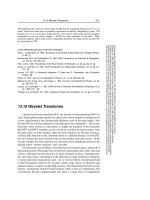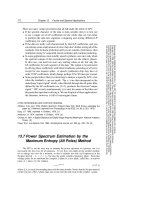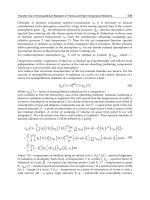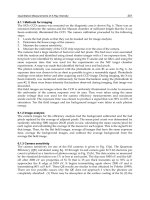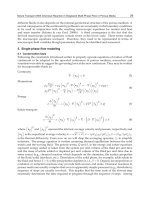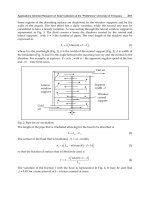Differential Equations and Their Applications Part 14 docx
Bạn đang xem bản rút gọn của tài liệu. Xem và tải ngay bản đầy đủ của tài liệu tại đây (730.64 KB, 20 trang )
250 Chapter 9. Numerical Methods of FBSDEs
Add the two inequalities above and apply Gronwall's lemma; we see that
sup(H~kI[ + IIckil) = V(h + At).
k
Applying the arguments similar to those in Theorem 2.3 we can derive the
following theorem.
Theorem 2.4.
Suppose that (A1)-(A3) hold.
Then,
-u(t,
z)] +
IV(~)(t,x) -u~(t,z)[}
= O(1).
sup { ]V(n) (t, x)
(t,~)
n
Moreover, for each fixed x E IR, U (n)
(.,
x) and V (~)
(., x) are
left-continuous;
for
fixed t C
[0, T],
U (~) (t, .) and V ('~)
(t, -)
are uniformly Lipschitz, with the
same Lipschitz constant that is independent of n.
w Numerical Approximation of the Forward SDE
Having derive the numerical solution of the PDE (1.5), we are now ready
to complete the final step: approximating the Forward SDE (1.4). Recall
that the FSDE to be approximated has the following form:
/0
(3.1)
Xt = x + s, Xs)ds +
~(s,
Xs)dWs,
where
b(t, x) = b(t, x, O(t,
x),
-a(t, x, O(t, x)O~ (t, x)) = bo
(t, x,
O(t, x), O~
(t, x));
~(t, x) = ~(t, x, o(t,
~)).
for (t, x) e [0, T] • IR.
To define the approximate SDEs, we need some notations. For each
n E IN, set At~ =
T/n, t ~,k = kAtn,
k = 0,1,2, ,n, and
n 1
(3.2) ~/n(t) =
Etn'kl[tn.~,t~.k+x)(t), t 9
[0, T);
k=0
gn(T) = T.
Next, for each n, let (U (n), V (n)) be the approximate solution to the PDE
(1.5), defined by (2.35) (in the special case we may consider only
u (n)
defined by (2.24)). Set
(3.3)
o~(t,x) = U(~)(T - t,x), on(t,~) = V(n)(T - t,x),
and
bn(t,x) =
bo(t,x, On(t,x),O'~(t,x));
~(t,x) =
a(t,x, On(t,x)).
By Theorem 2.4 we know that 0 = is right continuous in t and uniformly
Lipschitz in x, with the Lipschitz constant being independent of t and n;
w Numerical approximation of the FSDE 251
thus, so also are the functions ~n and yn. We henceforth assume that there
exists a constant K such that, for all t and n,
(3.4)
Ibn(t,x)
-bn(t,x')l +
I~n(t,x)
-~n(t,x')l _
KIx- x'l, x,x' e IR.
Also, from Theorem 3.4,
(3.5)
sup(b~(t,x)-b(t,x)l'+supl~n(t,x)-~(t,x)l
= O(1).
t,~ t,x
We now introduce two SDEs: the first one is a
discretized SDE
given
by
(3.6) 2/~=x+
g"(.,2?Lo(s)as + ~(.,2~),~(s)aw~,
where ~n is defined by (3.2). The other is an
intermediate approximate
SDE
given by
// //
(3.7)
X~ = x + b~(s, X2)ds +
Yn(s,
X2)dW~.
It is clear from the properties of ~n and ~n mentioned above that both
SDEs (3.6) and (3.7) above possess unique strong solutions.
We shall estimate the differences )(~ - X~ * and
X n - X,
separately.
LeInma 3.1. Assume
(A1) (A3). Then,
E{ sup IXT:-X:I 2} =0(1).
O<t<T
Proof.
To simplify notation, we shall suppress the sign "-" for the
coefficients in the sequel. We first rewrite (3.6) as follows:
/o //
2~ = No + u~ + bn(s, Xn)ds + an(s, f(n)dWs,
where
L /o
trbn,
f(n\
bn(s,22)]ds+
[an(.,2.~),
(~)_an(s,22)]dW~.
u~ =
L
k',
9
)n~(s)-
Applying Doob's inequality, Jensen's inequality, and using the Lipschitz
property of the coefficients (3.4) we have
E{ sup IX: - ~7:12 }
s<t
(~) _<~{ s~p i~nl ~ } + ~ ]/~{I~ n
-
~s~,~}~s
s<t
+ 12K 2
fE{lX$
-
J0
252
Chapter 9. Numerical Methods of FBSDEs
Now, set
as(t)
= E{ sups_< t [X~ - Xsnl2}. Then, from (3.8),
/o'
an(t) <
3E{ sup [un] 2 } + 3K2(T +4)
an(s)ds,
s<_t
and Gronwall's inequality leads to
(3.9) E~ sup[X n - Xsni 2 } <
3e3K~(T+4)E~
sup ]Uy]2~.
s<t ~ s<t J
We now estimate E{sups_< t ]uyl2}. Note that if s E
[tn'k,tn'k+l),
for
some 1 < k < n, then ??n(s) =
kAtn
(whence T - ~n(s) = (n - k)Atn, as
T = nat,)
and T - s E ((n - k - 1)Atn, (n - k)At~]. Thus, by definitions
(2.9) and (3.2), for every x E IR
0~(nn(~), ~) = ~(~)(T - nn(s), x) = ~(~)((~ - k)~t~, x)
: ur -
s,x) : O'~(s,x).
More generally, for all (s, x) E [0, T] x IR,
b'~(s,x) = b(s,x, On(s,x)) = b(s,x, On(~n(s),x)).
Using this fact, it is easily seen that
fo ~ b(v (~),X,o(~),O (v (~),
n -n n n -n
x,~(~))) - b(~,X n~ , O~(~,X:))
ds
/o'
~ { b(~n(s), f(vn~(~), On(s,
2~n~ (~))) -
b(s, X2, 9~(s,
2v~(~)) )
b ~ n -n __
+ (~,x~,o (~,x,o(~))) b(~,x:,on(~,x:)) }d~
=11 + I2.
Using the boundedness of the functions bt, b~ and
by,
we see that
{
~
~/o' { lt~ll~l~~ § H~JJ~I~,~-~:1}~,
/o'
I2 < K]lbyH~ . If(vS(s) - X2]ds.
Thus,
- + x jlds,
where h" depends only on
K, ]]btllc~, IIb~]l~
and Ilbvll~. Since
inn(s) -
sJds = (s - tk)ds < -~ k=o
w Numerical approximation of the FSDE 253
E{sup~<~ fo~b ~'~, 2 ~. ),~(s)- b~(8, X:)ds 2 }
(3.10)
0 t
T4
Using the same reasoning for a with Doob's inequality, we can see that
~{sup [ ~n(. X.~)~(~) _
~~ X:)eW~ 2}
u<t
(3.11) _< 8/~2 {
EIy;n(~)-XFI2ds+ (s-~n(s))2ds}
< 8~2{ fo ~
Combining (3.10) and (3.11), we get
fo t 16)1
E{sup
I,,~12} < ~(4T + 16) E[2~(~) -
X~[2ds + R~T(T + 3 ~2"
s<t
Thus, by (3.9),
.{ su8 ,~: - x:l ~ }
(3.12)
<_ 3e 3K2(T+4){/~2(4T
+ 16)
EI2,~.(~)
- X2[2ds
+K2T(T+~)n~ }-
Finally, noting that ] ~-(s) - X~I < I ~(~) - -~21 + 122 - X21 and that
we see as before that
fo EI2~(~)
-
2212ds <_ 2
IlbllL(s - v~(s)) 2 + [l~llLIs - v~(s)l
ds
< 2]lbll~T 1 1
- 3 n 2 +II~II~T n
Therefore, (3.12) becomes
i
t -n n 2
(3.13) E{suplXn x:I 2} <C, +C2z~+C3
f E#suPlX~-X~l
}as,
s<t It Jo t. r<s
where C1, C2 and Cz are constants depending only on the coefficients
b,
a and K and can be calculated explicitly from (3.12). Now, we conclude
from (3.13) and Gronwall's inequality that
~n(t) <_ /3ne CT,
Vt 6 [0, T],
254 Chapter 9. Numerical Methods of FBSDEs
where
/9~ = Cln -1 + C~n -2
and
CT = C3T.
In particular, by slightly
changing the constants, we have
an(T):E~ sup
IX:-Xnl 2}
< C, + 02 =0(i),
- 0<~<~ -~-
proving the lemma. []
The main result of this chapter is the following theorem.
Theorem 3.2.
Suppose that the standing assumptions (A1) (A3) hold.
Then, the adapted solution
(X,
Y, Z) to the FBSDE (1.1) can be approxi-
mated by a sequence of adapted processes
(X "n, Y~, Zn),
where f(~ is the
solution to the discretized SDE (3.6) and, for t 6
[0, T],
~n :: 8~(t,2tn); Z? :=
-a(t,2~,sn(t,f~))O~(t,f(?),
with O n and 0 n being defined by (3.3) and U (n) and V (~) by (2.34). Fur-
thermore,
(3.14) E{ 0<t<TSUp
]f(: XtI+O<t<TSUp
]~n Ytl+0<t<Tsup
I'~-Ztl}=O(~n).
Moreover, if f is C 2 and uniformly Lipschitz, then
for n large
enough,
(3.15)
E{f(2~,
2~)} -
EU(XT,
Z~)}[ _<
K
n
for a constant K.
Proo].
Recall that at the beginning of the proof of Lemma 3.1, we have
suppressed the sign "-" for b and ~ to simplify notation. Set
~n(t) = { sup Ibm(t, x) - b(t, x)l 2 + sup lan(t, x) a(t, ~)l ~
},
x x
where b, b n, a and a n are defined by (3.1) and (3.3). Then, from (3.5) we
know that sup t
Izn(t)l
= O(~A~). Now, applying Lemma 3.1, we have
~{
:~ I~: - ~J~}
_< ~{
~u~ i~:- ~:l ~ }. ~{ ~u~ i~: - ~sl ~ }
w Numerical approximation of the FSDE 255
Further, observe that
<_4T fot Elbn(s, X2) - bn(s, X~)[2ds
+ 16
Elan(s, X2) - a n
(s,
Xs)12ds +
4(T + 4)
r
~4(T + 4)K ~ E{ sup IX~ - X~I ~}es + 4(T + 4) ~n(s)e~.
r<_s
Applying Gronwall's inequality, we get
{ } Jo
(3.16) E sup
[X• - Xs[ 2 <
4(T + 4)
Sn(s)ds"
e 4(T+4)K2 <
n- ~,
s<t
where C is a constant depending only on K and T. Now, note that the
functions 0 and On are both uniformly Lipschitz in x. So, if we denote their
Lipschitz constants by the same L, then
0<t<T
_
on(t
2n~121
<
2E~
sup
lO(t, Xt)- ,
, t
:~ I
0<t<T
+ 2E{ sup 10~(t,22)-0(t,~)l 2}
0<t<T
0<t<T
(t,x)
by Theorem 3.4 and (3.16). The estimate (3.14) then follows from an
easy application of Cauchy-Schwartz inequality. To prove (3.15), note that
Theorem 2.3 implies that, for n large enough, snp(t,x)10n(t,x)
-0(t,
x)l
Cn -1,
for some (generic) constant C > 0. We modify )(~ as defined by
(3.6) by fixing n and approximating the solution X ~ of (3.7) by a standard
Euler scheme indexed by k:
f0 f0
2~ 'k = x + b(.,2.~,k)n,c(s)ds + a(.,2?'k),,,(s)dWs.
It is then standard (see, for example, Kloeden-Platen [1, p.460]) that
(3.17)
C1
E{:(X~)} - E{f(2~'k)} <_ K
256 Chapter 9. Numerical Methods of FBSDEs
On the other hand, we have
Ig{f(XT)}
- E{f(X~)}[ <_ KE{IXT -
X~[ }
(3.18)
C2
O~t~T ) ?2
for Lipschitzian f, by (3.16). Therefore, noting that X~ as defined by (3.6)
is just _~n,n
t , the triangle inequality, (3.17) and (3.18) lead to (3.15). []
Comments and Remarks
The main body of this book is built on the works of the authors, with
various collaboration with other researchers, on this subject since 1993.
Some significant results of other researchers are also included to enhance
the book. However, due to the limitation of our information, we inevitably
might have overlooked some new development in this field while writing
this book, for which we deeply regret.
In Chapter 1, the results on the pure BSDEs, especially the fundamen-
tal well-posedness result, are based on the method introduced in the seminal
paper of Pardoux-Peng [1]. The results on nonsolvability of FBSDEs are
inspired by the example of Antonelli [1]. The well-posedness results of FB-
SDEs over small duration is also based in the spirit of the work of Antonelli
[1]. The whole Chapter 2 is based on the paper of Yong [4].
In Chapter 3 we begin to consider a general form of the FBSDE (1)
with an arbitrarily given T > 0. The main references for this chapter
are based on the works of Ma-Yong [1], virtually the first result regarding
solvability of FBSDE in this generality; and Ma-Yong [4], in which the
notion of
approximate solvability
is introduced. A direct consequence of the
method of optimal control is the Four Step Scheme presented in Chapter 4.
The finite horizon case is initiated by Ma-Protter-Yong [1]; and the infinite
horizon case is the theoretical part of the work on "Black's Consol Rate
Conjecture" presented later in Chapter 8, by Duffie-Ma-Yong [1].
Chapter 5 can be viewed either as a tool needed to extend the Four Step
Scheme to the situation when the coefficients are allowed to be random, or
as an independent subject in stochastic partial differential equations. The
main results come from the papers of Ma-Yong [2] and [3]; and the appli-
cations in finance (e.g, the stochastic Black-Scholes formula) are collected
in Chapter 8.
The method of continuation of Chapter 6 is based on the paper of Hu-
Peng [2], and its generalization by Yong [1]. The method adopted a widely
used idea in the theory of partial differential equations. Compared to the
Four Step Scheme, this method allows the randomness of the coefficients
and the degeneracy of the forward diffusion, but requires some analysis
which readers might find difficult in a different way.
Chapter 7 is based on the work of Cvitanic-Ma [2]. The idea for the
forward SDER using the solution mapping of Skorohod problem is due
to Anderson-Orey [1], while the Lipschitz property of such solution map-
ping is adopted from Dupuis-Ishii [1]. The proof of the backward SDER
is a modification of the arguments of Pardoux-Rascanu [1], [2], as well as
some arguments from BuckdahmHu [1]. The proof of the existence and
uniqueness of FBSDER adopted the idea of Pardoux-Tang [1], a general-
ized method of contraction mapping theorem, which can be viewed as an
independent method for solving FBSDE as well.
258 Comments and Remarks
Chapter 8 collects some successful applications of the FBSDEs devel-
oped so far. The integral representation theorem is due to Ma-Protter-Yong
[1]; the Nonlinear Feynman-Kac formula is in the spirit of Peng [4], but the
argument of the proof follows more closely those of Cvitanic-Ma [2]. The
Black's consol rate conjecture is due to Duffie-Ma-Yong [1]; while hedging
contingent claims for large investors comes from Cvitanic-Ma [1] for uncon-
straint case, and from Buckdahn-Hu [1] for constraint case. The section on
stochastic Black-Scholes formula is based on the results of Ma-Yong [2] and
[3], and the American game option is from Cvitanic-Ma [2].
Finally, the numerical method presented in Chapter 9 is essentially
the paper of Douglas-Ma-Protter [1], with slight modifications. We should
point out that, to our best knowledge, the scheme presented here is the
only numerical method for (strongly coupled) FBSDEs discovered so far,
and even when reduced to the pure BSDE case, it is still one of the very
few existing numerical methods that can be found in the literature.
In summary, FBSDE is a new type of Stochastic differential equations
that has its own mathematical flavor and many applications. Like a usual
two-point boundary value problem, there is no generic theory for its solv-
ability, and many interesting insights of the equations has yet to be dis-
covered. In the meantime, although the theory exists only for such a short
period of time (recall that the first paper on FBSDE was published in
19930, many topics in theoretical and applied mathematics have already
been found closely related to it, and its applicability is quite impressive.
It is our hope that by presenting a lecture notes in the series of LNM,
more attention would be drawn from the mathematics community, and the
beauty of the problem would be further exposed.
References
Ahn, H., Muni, A., and Swindle, G.,
[1] Misspecified asset pricing models and robust hedging strategies,
preprint.
Anderson, R. F. and Orey, S.,
[1] Small random perturbation of dynamical systems with reflecting
boundary,
Nagoya Math. J.,
60 (1976), 189-216.
Antonelli, F.,
[1] Backward-forward stochastic differential equations, Ann.
Appl. Prob.,
3 (1993), 777-793.
Bailey, P. B., Shampine, L. F., and Waltman, P. E.,
[1]
Nonlinear Two Point Boundary Value Problems,
Academic Press, New
York, 1968.
Barbu, V.,
[1]
Nonlinear Semigroups and Differential Equations in Banach Spaces,
Noordhoff Internation Publishing, 1976.
Barles, G., Buckdahn, R., and Pardoux, E.,
[1] Backward stochastic differential equations and integral-partial differen-
tial equations,
Stochastics
and
Stochastics Reports,
60 (1997), 57-83.
Bellman, R., and Wing, G. M.,
[1] An
Introduction to Invariant Imbedding,
John Wiley & Sons, New
York, 1975.
Bensoussan, A.,
[1] Stochastic maximum principle for distributed parameter systems, J.
F~anMin Inst.,
315 (1983), 387-406.
[2] Maximum principle and dynamic programming approaches of the op-
timal control of partially observed diffusions,
Stochastics,
9 (1983),
169-222.
[3] On the theory of option pricing,
Acta Appl. Math.,
2 (1984), 139-158.
[4]
Perturbation Methods in OptimM Control,
John-Wiley & Sons, New
York, 1988.
[5]
Stochastic Control of Partially Observable Systems,
Cambridge Uni-
versity Press, 1992.
Bergman, Y.Z., Grundy, B.D., and Wiener, Z.,
[1] General Properties of Option Pricing, Preprint, 1996.
Bismut, J. M.,
[1] Th~orie Probabiliste du Contr61e des Diffusions, Mere. Amer.
Math.
Soc.
176, Providence, Rhode Island, 1973.
260 References
[2] An introductory approach to duality in optimal stochastic control,
SIAM
Rev., 20 (1978), 62-78.
Black, F., and Scholes, M.,
[I] The pricing of options and corporate liability, J.
Polit. Economy,
81
(1973), 637-659.
Borkar, V. S.,
[1]
Optimal Control of Diffusion
Processes, Longman Scientific & Techni-
cal, 1989.
Brennan, M., and Schwartz, E.,
[1] A continuous time approach to the pricing of bonds,
J. Banking &
Finance,
3
(1979), 133-155.
Buckdahn, R.,
[1] Backward stochastic differential equations driven by a martingale,
preprint.
Buckdahn, R., and Hu, Y.,
[1] Hedging contingent claims for a large investor in an incomplete market,
Advances in Applied Probability,
30 (1998), 239-255.
Buckdahn, R., and Pardoux, E.,
[1] BSDE's with jumps and associated integral-stochastic differential equa-
tions, preprint.
Caffarelli, L. A., and Friedman, A.,
[1] Partial regularity of the zero-set of semilinear and superlinear elliptic
equations, J.
Diff. Eqs.,
60 (1985), 420-433.
Cannarsa, P., and Soner, H. M.,
[1] On the singularities of the viscosity solutions to Hamilton-Jacobi-
Bellman equations,
Indiana Univ. Math. J.,
36 (1987), 501-524.
Casti, J., and Kalaba, R.,
[1]
Imbedding Methods in Applied Mathematics,
Addison-Wesley Pub.,
London, 1973.
Chen, S., and Yong, J.,
[1] Stochastic linear quadratic optimal control problems, preprint.
Courant, R., and Hilbert, D.,
[1]
Methods of Mathematical Physics, Voi.1,
Interscience, New York, 1953.
Crandall, M.G., Ishii, H., and Lions, P.L.,
[1] User's guide to viscosity solutions of second order partial differential
equations,
Buff.
Amer.
Soc.,
27 (1992), 1-67.
Cvitanic, J., and Karatzas, I.,
[1] Hedging contingent claims with constrained portfolios,
Ann. of Appl.
Probab.
3 (1993), 652-681.
References 261
[2] Backward stochastic differential equations with reflection and Dynkin
games,
Ann. of Proba.,
24 (1996), 2024-2056.
Cvitanic, J., and Ma, J.,
[1] Hedging options for a large investor and forward-backward SDEs,
Ann.
Appl. Probab.,
6 (1996), 370-398.
[2] Forward-backward stochastic differential equations with reflecting
boundary conditions, preprint.
Darling, R. W. R.,
[1] Martingales on non-compact manifolds: maximal inequalities and pre-
scribed limits, preprint.
[2] Constructing Gamma-martingales with prescribed limit using back-
ward SDE, preprint.
Darling, R. W. R., and Peng, S.,
[1] An useful nonlinear version of conditional expectation, preprint.
Deimling, K.,
[1]
Nonlinear Functional Analysis,
Springer-Verlag, Berlin, 1988.
Dellacherie, C., and Meyer, P. A.,
[1]
Probabilities
and
Potentials B,
North Holland, 1982.
Detemple. J.,
[1] Intertemporal asset pricing with incomplete markets and nontraded
assets, preprint.
Donnelly, H., and Fefferman, C.,
[1] Nodal sets of eigenfunctions on Riemannian manifolds,
Invent. Math.,
93 (1988), 161-183.
Douglas, J.,Jr., Ma, J., and Protter, P.,
[1] Numerical methods for forward-backward stochastic differential equa-
tions,
Ann. Appl. Probab.,
6 (1996), 940-968.
Duffle, D.,
[1]
Security Markets: Stochastic Models,
Boston, Academic Press, 1988.
[2]
Dynamic
Asset
Pricing Theory,
Princeton Univ. Press, 1992.
Duffle, D., Epstein, .L,
[1] Stochastic differential utility,
Econometrica,
60 (1992), 353-394.
[2] Asset pricing with stochastic differential utilities,
Review of Financial
Studies,
5 (1992), 411-436.
Duffle, D., Geoffard, P. Y., and Skiadas, C.,
[1] Efficient and equilibrium allocations with stochastic differential utility,
J. Math. Economics,
23 (1994), 133-146.
262 References
Duffle, D., and Lions, P. L.,
[1] PDE solutions of stochastic differential utility,
J. of Mathematical Eco-
nomics,
21 (1993), 577-606.
Duffle, D., Ma, J., and Yong, J.,
[1] Black's consol rate conjecture,
IMA preprint #1164,
July, 1993; also,
Ann. Appl. Probab.,
5 (1995), 356-382.
Dupuis, P. and Ishii, H.,
[1] On Lipschitz continuity of the solution mapping to the Skorokhod prob-
lem, with applications,
Stoch. ~: Stoch. Rep.,
35 (1991), 31-62.
E1 Karoui, N., Huu Nguyen, D., and Jeanblanc-Picqu~, M.,
[1] Compactification methods in the control of degenerate diffusions: ex-
istence of an optimal control,
Stochastics,
20 (1987), 169-219.
[2] Existence of an optimal Markovian filter for the control under partial
observations,
SIAM J. Control ~ Optim.,
26, (1988), 1025-1061.
E1 Karoui, N., and Jeanblanc-Picqu6, M.,
[1] Optimization of consumption with labor income, preprint.
E1 Karoui, N., Jeanblanc-Picqu6, M., and Shreve, S. E.,
[1] Robustness of the Black and Scholes formula, preprint.
E1 Karoui, N., Kapoudjian, C., Pardoux, E., Peng, S., and Quenez, M. C.,
[1] Reflected solutions of backward SDE's and related obstacle problems
for PDE's,
Ann. of Proba.,
25 (1997), 702-737.
E1 Karoui, N., Peng, S., and Quenez, M C.,
[1] Backward stochastic differential equation in finance,
Mathematical Fi-
nance,
7 (1997), 1-71.
E1 Karoui, N., and Quenez, M C.,
[1] Dynamic programming and pricing of contingent claims in an incom-
plete market, preprint.
Epstein, L.,
[1] The global stability of efficient intertemporal allocations,
Economet-
rica,
55 (1987), 329-355.
Fleming, W. H.,
[1] The Cauchy problem for a nonlinear first order differential equation, J.
Diff. Eqs.,
5 (1969), 515-530.
[2]
Generalized Solutions in Optimal Stochastic Control,
Differential
games and control theory II, Lect. Notes in Pure and Appl. Math., 30,
Dekker, 1977.
Fleming, W. F., and Soner, M.,
[1]
Controlled Markov Processes and Viscosity Solutions,
Springer-Verlag,
New York, 1993.
References 263
Friedman, A.,
[1] Partial Differential Equations of Parabolic Type, Prentice-Hall, Inc.,
Englewood Cliffs, N.J., 1964.
[2] Stochastic Differential Equations and Applications, Vol. 1, Academic
Press, 1975.
Geoffard, P. Y.,
[1] Discounting and optimizing, preprint.
Gilbarg, D., and Trudinger, N. S.,
[1] Elliptic Partial Differential Equations of Second Order, Springer-
Verlag, Berlin, 1977.
Hamadene, S.
[1] Backward-forward stochastic differential equations and stochastic
games, preprint.
Hamadene, S., and Lepeltier, J. P.,
[1] Zero-sum stochastic differential games and backward equations, Sys.
Control Left., 24 (1995), 259-263.
Hardt, R., and Simon, L.,
[1] Nodal sets for solutions of elliptic equations, J. Diff. Geom., 30 (1989),
505-522.
Harrison, M., and Kreps, D.
[1] Martingales and arbitrage in multiperiod securities markets, J. Eco-
nomic Theory, 20 (1979), 381-408.
Haussmann, U.
G.,
[1] On the Integral Representation of F~nctionals of It6's Processes,
Stochastics, 3 (1979), 17-27.
Hiriart-Urruty, J-B., and Lemar6chal, C.,
[1] Convex Analysis and Minimization Algorithms, I., Springer-Verlag,
1993.
Hogan, M.
[1] Problems in certain two factor term structure models, Ann. AppI.
Probab., 3 (1993), 576-581.
HSrmander, L.,
[1] The Analysis of Linear Partial Differential Operators, I., Springer-
Verlag, Berlin, 1983.
Hu, Y.,
[1] N-person differential games governed by semilinear stochastic evolution
systems, Appl. Math. Optim., 24 (1991), 257-271.
264 References
[2] Probabilistic interpretation of a system of quasilinear elliptic partial dif-
ferential equations under Neumann boundary conditions,
Stoch. Proc.
Appl.,
48 (1993), 107-121.
Hu, Y., and Peng, S.,
[1] Adapted solution of backward stochastic evolution equation,
Stoch.
Anal. ~: App1.,
9 (1991), 445-459.
[2] Solution of forward-backward stochastic differential equations,
Probab.
Theory ~ Re1. Fields,
103 (1995), 273-283.
Ikeda, N., and Watanabe, S.,
[1]Stochastic Differential Equations and Diffusion Processes,
North Hol-
land, Amsterdam, 1981.
John, F.,
[1]
Partial Differential Equations,
Springer-Verlag, 1975.
Karatzas, I., and Shreve, S. E.,
[1]
Brownian Motion and Stochastic Calculus,
Springer-Verlag, Berlin,
1988.
Kloeden, P.E. and Platen, E.,
[1]
Numerical Solution of Stochastic Differential Equations,
Springer-
Verlag, 1992.
Koopmans, T.
[1] Stationary ordinary utility and impatience,
Econometrics,
28 (1960),
287-309.
Krylov, N. V.,
[1]
Controlled Diffusion Processes,
Springer-Verlag, New York, 1980.
[2]
Nonlinear Elliptic and Parabolic Equations of the Second Order,
Reidel,
Dordrecht, Holland, 1987.
Krylov, N. N., and Rozovskii, B. L.,
[1] Stochastic partial differential equations and diffusion processes,
Us-
pekhi Mat. Nauk,
37 (1982), No.6, 75-95.
Kunita, H.,
[1]
Stochastic Flows and Stochastic Differential Equations,
Cambridge
University Press, 1990.
Ladyzenskaja, O. A., Solonnikov, V. A., and Ural'ceva, N. N.,
[1]
Linear and Quasilinear Equations of Parabolic Type,
AMS, Providence,
RI., 1968.
Lepeltier, M., and San Martin, J.
[1] Backward stochastic differential equations with non-Lipschitz coeffi-
cients,
Stat. &: Prob. Letters,
32 (1997), 425-430.
References 265
Li, X., and S. Tang,
[1] General necessary conditions for partially observed optimal stochastic
control, J.
Appl. Prob.,
32 1995), 1118-1137.
Lin, F. H.,
[1] Nodal sets of solutions of elliptic and parabolic equations,
Comm.
Pure
Appl. Math.,
44 (1991), 287-308.
Lions, J. L.,
[1]
l~quations Diff~rantielles Op@rationnelles et Probl@mes aux Limites,
Springer-Verlag, Berlin, 1961, 2nd Edition.
Ma, C.,
[1] Market equilibrium with heterogeneous recursive utility maximizing
agents,
Economic Theory,
3 (1993), 243-266.
[2] Intertemporal recursive utility in the presence of mixed Poisson-
Brownian uncertainty, preprint.
[3] Valuation of derivative securities with mixed Poisson-Brownian infor-
mation and recursive utility, preprint.
Ma, J., Protter, P., and Yong, J.,
[1] Solving forward-backward stochastic differential equations explicitly
a four step scheme,
IMA preprint #1146,
June, 1993; also,
Prob.~:
Related Fields,
98 (1994), 339-359.
Ma, J., and Yong, J.,
[1] Solvability of forward backward SDEs and the nodal set of Hamilton-
Jaccobi-Bellman Equations,
IMA preprint #1117,
March, 1993; also,
Chin. Ann. Math.,
16B (1995), 279-298.
[2] Adapted solution of a degenerate backward SPDE, with applications,
Stochastic Processes and their Applications,
70 (1997), 59-84.
[3] On linear, degenerate backward stochastic partial differential equations,
Probab. Theory
Re/at.
Fields,
to appear.
[4] Approximate solvability of forward-backward stochastic differential
equations, preprint.
Meyer, G. H.,
[1]
Initial
Value
Methods
for
Boundary Value Problems Theory
and
Application of Invariant Imbedding,
Academic Press, New York, 1973.
Nualart, D.,
[1] Noncausal Stochastic Integrals and Calculus,
Stochastic Analysis and
Related Topics,
Korezlioglu, H. and Ustunel, A. S. eds. Lect. Notes
Math., vol.1316, Springer-Verlag, Berlin, 1986, 80-129.
[2]
Malliavin Calculus and Related Topics,
Springer-Verlag, 1995.
Nualart, D., and Pardoux, E.,
[1] Stochastic calculus with anticipating integrands,
Prob. Th. Rel.
Fields,
78 (1988), 535-581.
266 References
Ocone, D.,
[1] Malliavin's Calculus and Stochastic Integral Representations of Func-
tionals of Diffusion Processes,
Stochastics,
12 (1984), 161-185.
Ocone, D., and Pardoux, E.,
[1] Linear stochastic differential equations with boundary conditions,
Probab. Th. Rel. Fields,
82 (1989), 489-526.
[2] A stochastic FeynmamKac formula ibr anticipating SPDE's, and ap-
plication to nonlinear smoothing,
Stoch. 35 Stoch. Rep.,
45 (1993),
79-126.
Pardoux, E.,
[1] Stochastic partial differential equations and filtering of diffusion pro-
cesses,
Stochastics,
3 (1979), 127-167.
[2] Backward stochastic differential equations and applications,
Proc.
ICM,
1994.
Pardoux, E., and Peng, S.,
[1] Adapted solution of a backward stochastic differential equation,
Sys-
tems 35 Control Left.,
14 (1990), 55-61.
[2] Backward stochastic differential equations and quasilinear parabolic
partial differential equations,
Lecture Notes in CIS
176, 200-217,
Springer 1992.
[3] Backward doubly stochastic differential equations and systems of quasi-
linear parabolic SPDEs,
Probab. Theory 35 Related Fields,
98 (1994),
209-227.
[4] Some Backward stochastic differential equations with non-Lipschitz co-
efficients, preprint.
Pardoux, E., and Protter, P.,
[1] A two-sided stochastic integral and its calculus,
Probab. Th. Rel.
Fields,
76 (1987), 15-49.
Pardoux, E., and Rascanu, A.,
[1] Backward stochastic differential equations with subdifferential opera-
tor and related variational inequalities,
Stochastic Process. App1., 76
(1998), no. 2, 191-215.
[2] Backward stochastic differential equations with maximal monotone op-
erators, preprint.
Pardoux, P., and Tang, S.,
[1] The study of forward-backward stochastic differential equation and its
application in quasilinear PDEs, preprint.
Peng, S.,
[1] A general stochastic maximum principle for optimal control problems,
SIAM J. Control ~ Optim.,
28 (1990), 966-979.
[2] A generalized Hamilton-Jacobi-Bellman equation,
Lecture Notes in
CIS, 184, Li & Yong eds,
126-134, Springer-Verlag, Berlin, 1991.
References 267
[3] Probabilistic interpretation for systems of quasilinear parabolic partial
differential equations,
Stoch. g~ Stoch. Rep.,
37 (1991), 61-74.
[4] A nonlinear Feynman-Kac formula and applications,
Proc. Symposium
of System Sciences
and
Control Theory,
Chen s
Yong
eds. 173-184,
World Scientific, Singapore, 1992.
[5] Stochastic Hamilton-Jacobi-Bellman equations,
SIAM J. Control ~: Op-
tim.,
30 (1992), 284-304.
[6] A generalized dynamic programming principle and Hamilton-Jacobi-
Bellmen equation,
Stoch. ~= Stoch. Rep.,
38 (1992), 119-134.
[7] New development in stochastic maximum principle and related back-
ward stochastic differential equations,
Proc. 31st CDC,
Tucson 1992.
[8] Backward stochastic differential equation and its application in optimal
control,
Appl. Math. ~: Optim.,
27 (1993), 125-144.
[9] Backward SDE and related g-expectation, preprint.
[10] Adapted solution of backward stochastic differential equations and re-
lated partial differential equations, preprint.
Peng, S., and Wu, Z.,
[1] Fully coupled forward-backward stochastic differential equations,
preprint.
Picard, J.,
[1] Martingales on Riemannian manifolds with prescribed limits, J. Fhnct.
Anal.,
99 (1991), 223-261.
[2] Baricentres et martingales sur une varietY,
Ann. de I'IHP,
to appear.
Protter, P.,
[1]
Stochastic Integration and Differential Equations, A New Approach,
Springer-Verlag, Berlin, 1990.
Rozovskii, B. L.,
[1]
Stochastic Evolution Systems: Linear Theory and Applications to Non-
linear Filtering,
Kluwer Academic Publishers, Boston, 1990.
Schroder, M. and Skiadas, C.,
[1] Optimal consumption and portfolio selection with stochastic differential
utility, preprint.
Scott, M. R.,
[1]
Invariant Imbedding and Its Applications to Ordinary Differential
Equations An Introduction,
Addison-Wesley Pub., London, 1973.
Shreve, S. E., and Soner, H. M.,
[1] Optimal investment and consumption with transaction costs, to appear.
Sowers, R.,
[1] Short-time geometry of random heat kernels, preprint.
Tang, S.,
[1] Optimal control of stochastic systems in Hilbert space with random
jumps, Ph. D Thesis, Fudan Univ., 1992.
268 References
Tang, S., and X. Li,
[1] Necessary conditions for optimal control of stochastic systems with
random jumps, SIAM J. Control 3z Optim., 32 (1994), 1447-1475.
Thalmaier, A.,
[1] Martingales on Riemannian manifolds and the nonlinear heat equation,
Stochastic Analysis and Applications, Davies et al eds., World Scientific
Press, Singapore, 1996, 429-440.
[2] Brownian motion and the formation of singularities in the heat flow for
harmonic maps, Probab. Theory Relat. Fields, 105 (1996), 335-367.
Wiegner, M.,
[1] Global solutions to a class of strongly coupled parabolic systems, Math.
Ann., 292 (1992), 711-727.
Wonham, W. H.,
[1] Linear Multivariable Control: A Geometric Approach, Springer-Verlag,
Berlin, 1980.
Yong, J.,
[1] Finding adapted solutions of forward-backward stochastic differential
equations method of continuation, Prob. Theory 8z Rel. Fields, 107
(1997), 537-572.
[2] Relations among ODEs, PDEs, FSDEs, BSDEs, and FBSDEs, Proc.
36th CDC, 2779-2784.
[3] Some results on the reachable sets of linear stochastic systems, Proc.
37th CDC, 1335-1340.
[4] Linear forward-backward stochastic differential equations, Appl. Math.
Optim., to appear.
[5] European type contingent claims in an incomplete market with con-
strained wealth and portfolio, preprint.
Yong, J., and Zhou, X. Y.,
[1] Stochastic Controls: Hamiltonian Systems and HJB Equations,
Springer-Verlag, New York, 1999.
Zhou, X. Y.,
[1] A unified treatment of maximum principle and dynamic programming
in stochastic controls, Stoch. ~ Stoch. Rep., 36 (1991), 137-161.
[2] A duality analysis on stochastic partial differential equations, J. Fanct.
Anal., 103 (1992), 275-293.
[3] On the necessary conditions of optimal controls for stochastic partial
differential equations, SIAM J. Control Optim., 31 (1993), 1462-1478.
Index
A
adapted solution, 10,25,138
approximate, 54
classical, 105
strong, 105
weak, 105
adjoint equation, 4
aggregator, 5
allocation, 6
a-efficient, 6
American game option, 232
appreciation rate, 7,208
approximate solvability, 54
B
Bellman's principle of optimality, 58
Black-Scholes formula
stochastic, 228
robustness of, 231
Black's conjecture, 202
bond, 7
bridge, 139
BSDE, 3
BSDER, 171
BSPDE, 103
Brownian motion, 1
C
charasteristics, 237,247
comparison theorem, 22,130,214,217
condition
monotone, 151
Novikov, 23
consumption, 7,208
contingent claim, 7
control, 3,33,52
controllability, 33,52
cost functional, 3,53
current utility function, 5
D
dynamic programming method, 57
differential utility, 5
E
equation
adjoint, 4
Hamilton-Jacobi-Bellman, 60
Riccati, 46
state, 3
stochastic differential, 1
backward, 3
forward-backward, 1,4
European option, 7
exercise price, 7
expiration date, 7
F
FBSDE, 1,4
FBSDER, 181
formula
stochastic Black-Scholes, 228
Feynman-Kac, 197
FSDER, 169
Four Step Scheme, 81
function
representing, 90
utility, 5
value, 58
G
Gelfand triple, 111
H
Hamiltonian, 59
hedging strategy, 8,209
I
indicator, 175
L
large investor, 207
M
maturity date, 7
method of
continuation, 137
optimal control, 51

